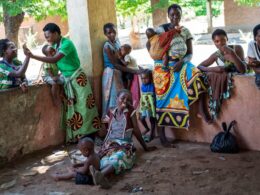The Lancet
Federico Boiardi, Justin Stebbing
February 17, 2022
ecancer
Key messages (about reducing delays in diagnostics)
by Joaquim Cardoso MSc.
Chief Strategy Officer of “The Digital Oncology Institute”
March 12, 2022
- Increases in diagnostic delays may be mitigated by employing targeted telehealth programs; the web-based awareness campaign ‘ HeadSmart’ in the UK was associated with a decrease in the median total diagnostic interval for paediatric brain tumours from 14 weeks pre-campaign to 6.7 weeks in 2013.
- Similarly, other outpatient alternatives, including synchronous telehealth modalities ( i.e., audio-video interaction between physician and patient), could address the aforementioned risks that cancer patients would otherwise face in an inpatient setting.
- Moreover, protective measures such as booster shots, which have recently been authorised for immunocompromised children aged 5 to 11 by the FDA, will hopefully result in more optimised outcomes for paediatric cancer patients (especially those with haematologic malignancies).
Other messages:
- Research in London revealed a 60% fall in cancer trial recruitment in England, as of 2020–21.
- The overall case fatality rate of COVID-19-infected patients with cancer was 22.4% , whereas that of COVID-19-infected inpatients without cancer was 5.9% .
- … a UK national study projected that diagnostic delays due to the pandemic could increase mortality by as much as 16.6%, depending on the cancer type, up to five years following diagnosis.
- However, within the context of paediatric cancer, research on the relationship between diagnostic delays and outcome has been conflicting.
ORIGINAL PUBLICATION (full version)

Developments in paediatric cancer care throughout the COVID-19 pandemic: Lessons from China
The Lancet
Federico Boiardi, Justin Stebbing
February 17, 2022
ecancer
Disruptions in cancer diagnoses, treatment, and research due to the COVID-19 pandemic have been well documented thus far.
Research in Europe and the US unveiled significant nationwide reductions in screenings, visits, therapy, surgeries, and hospitalisations across several cancer types, and more recent data published by the Institute of Cancer Research in London revealed a 60% fall in cancer trial recruitment in England, as of 2020–21.
In The Lancet Reginal Health — Western Pacific, Xiao et al. now quantify the impact of the pandemic on paediatric cancer inpatient care in China and, helpfully, stratify their findings by demographic subgroups.
In this retrospective study, the team collected medical record data for paediatric inpatients admitted from 2015 to May 2021 from a large tertiary hospital in Eastern China.
The majority ( ≈80%) of these patients were admitted with leukaemia. A quasi-experimental negative binomial regression model was employed to estimate the change in monthly admissions of paediatric cancer patients due to the pandemic.
This was then repeated and stratified by categorical factors such as age (<5 vs ≥5), sex, residence ( rural vs urban) and the episode of care ( first-time vs all admissions).
Relative risk estimates representing monthly admissions compared with expected admissions, had the pandemic not occurred, were then derived.
In February 2020, when the most rigorous mobility restrictions ( e.g., lockdown) were first imposed, a 33% ( P<0.0001) reduction across all admissions was observed, with the largest relative reductions amongst first-time admissions (-48%, P=0.0006) and admissions for patients from rural districts (-46%, P<0.0001), presumably due to difficulties travelling to the hospital.
Admissions then recovered in March 2020 as mobility restrictions such as intracity public transportation improved.
In aggregate, decreases in admissions for younger patients and patients from rural districts were more profound, and recovery as lockdown eased was slower compared with older patients and patients from urban districts.
By May 2021, all cohorts surpassed their pre-pandemic level, with the exception of female patients and first-time admissions.
Statistically significant reductions throughout the pandemic period were, in fact, only discernible for younger patients and first-time admissions.
These findings suggest that mobility restrictions resulted in the observed reduction in the number of hospital admissions.
Confounding variables include prioritisation of care and resources for COVID-19-infected patients, as well as fear of hospital-acquired infection.
Not only are cancer patients often immunocompromised, making them more susceptible to infection, but they also have an increased risk of mortality and morbidity from COVID-19.
One systematic review of 15 studies ( conducted by one of us, J.S.) found that
- the overall case fatality rate of COVID-19-infected patients with cancer was 22.4% ( 95% CI = 17.3% to 28.0%),
- whereas that of COVID-19-infected inpatients without cancer was 5.9% ( 95% CI = 1.9% to 11.7%).
… the overall case fatality rate of COVID-19-infected patients with cancer was 22.4% , whereas that of COVID-19-infected inpatients without cancer was 5.9% .
Early diagnosis and intervention in oncology are often, but not always, pivotal in terms of an association with a better prognosis.
For instance, a UK national study projected that diagnostic delays due to the pandemic could increase mortality by as much as 16.6%, depending on the cancer type, up to five years following diagnosis.
However, within the context of paediatric cancer, research on the relationship between diagnostic delays and outcome has been conflicting.
… a UK national study projected that diagnostic delays due to the pandemic could increase mortality by as much as 16.6%, depending on the cancer type, up to five years following diagnosis.
However, within the context of paediatric cancer, research on the relationship between diagnostic delays and outcome has been conflicting.
One systematic review highlights how studies concerning chronic lymphocytic, chronic myeloid, and acute myeloid leukaemias have all found no association between the time of diagnosis and outcome, making it difficult to forecast the implications of diagnostic delays on the prognoses of these paediatric cancer patients in particular.
In the study here, as all the data was obtained from a single hospital, the findings and its inferences are not definitively generalisable to a broader context.
Additionally, the prevalence of patients with haematologic malignancies prohibits the analysis of discrepancies in healthcare provision for different cancer types, notably solid tumours.
However, pursuant to recent research published in JAMA Oncology, it appears that vaccine effectiveness in adults with such malignancies ( 19%, 95% CI = -68% to 65%) is poorer than those with solid tumours ( 66%, 95% CI = 48% to 79%).

Given the additional risks these patients in particular confront, this warrants increased vigilance and vaccination with prioritised booster shots.
- Increases in diagnostic delays may be mitigated by employing targeted telehealth programs; the web-based awareness campaign ‘ HeadSmart’ in the UK was associated with a decrease in the median total diagnostic interval for paediatric brain tumours from 14 weeks pre-campaign to 6.7 weeks in 2013.
Increases in diagnostic delays may be mitigated by employing targeted telehealth programs; the web-based awareness campaign ‘ HeadSmart’ in the UK was associated with a decrease in the median total diagnostic interval for paediatric brain tumours from 14 weeks pre-campaign to 6.7 weeks in 2013.
- Similarly, other outpatient alternatives, including synchronous telehealth modalities ( i.e., audio-video interaction between physician and patient), could address the aforementioned risks that cancer patients would otherwise face in an inpatient setting.
Despite being worthy of a mention, it should be noted that the implementation of telehealth services can potentially exacerbate socioeconomic disparities in healthcare delivery.

The unprecedented global impact of the pandemic has inevitably had consequences for the utilisation of oncology services. However, lessons can be drawn from the available research discussed here.
In an effort to address the pandemic’s overall and differential impact on paediatric cancer care, many factors that ought to be considered are apparent, including
- the benefits and disadvantages of inpatient versus outpatient management, such as those addressed here.
- Moreover, protective measures such as booster shots, which have recently been authorised for immunocompromised children aged 5 to 11 by the FDA, will hopefully result in more optimised outcomes for paediatric cancer patients ( especially those with haematologic malignancies).
Further investigation is required to delineate how the pandemic’s impact on paediatric cancer care is affecting health outcomes compared to the pre-pandemic period.
The story in paediatric cancer care is not yet complete here; most studies regarding COVID-19 and cancer are exclusively focused on adult patients with solid tumours and have been limited to the US and Europe.
Consequently, systematic reviews similar to those previously conducted for adults are necessary to consolidate a comprehensive understanding of the interplay between COVID-19 and paediatric cancer.
References and additional information
See the original publication
About the authors
Federico Boiardi,a * and
Justin Stebbing b
a Imperial College, London, UK
b Department of Surgery and Cancer, Imperial College, London, UK
Originally published at https://www.thelancet.com.












